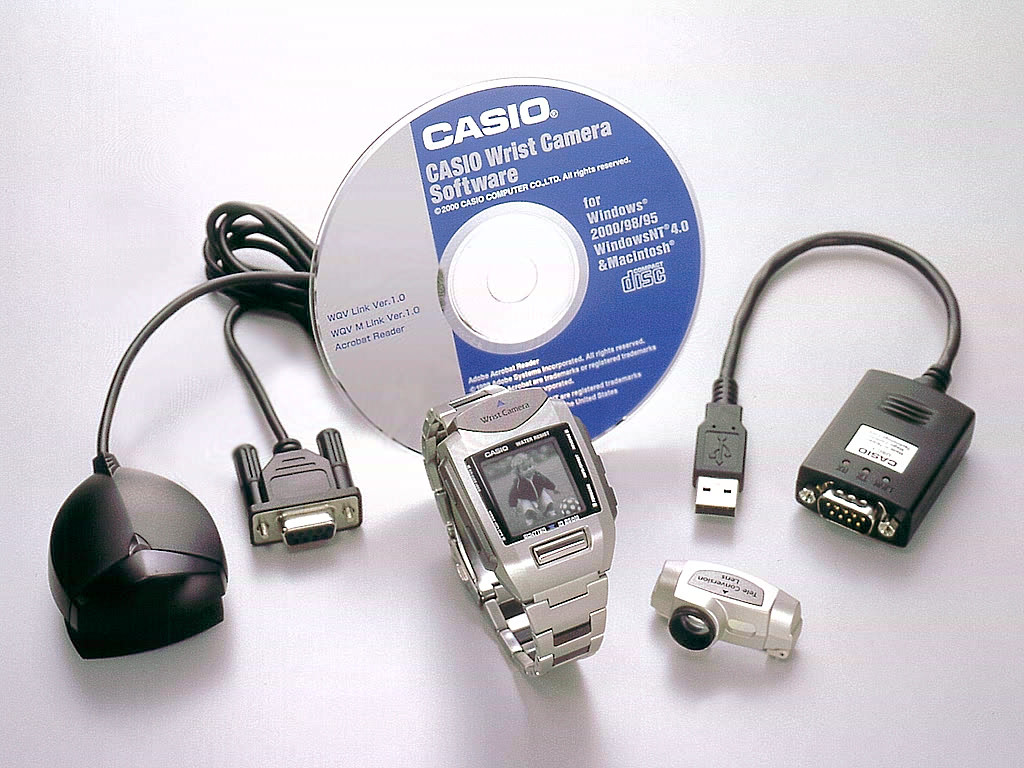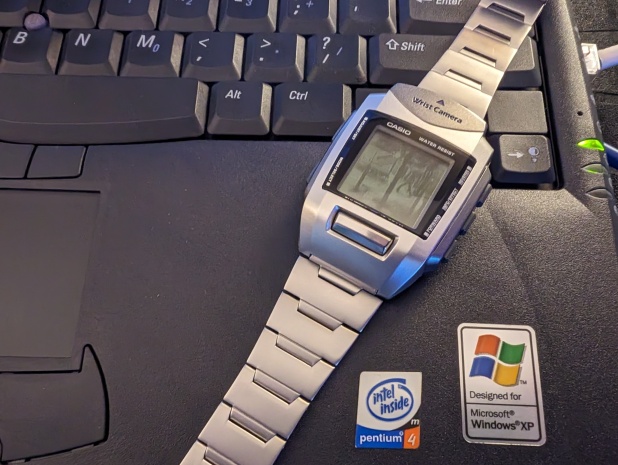I have gone to extreme lengths to get this thing to talk to a computer and I want to share a bunch of information about this watch with the internet.
For the unitiated, the Casio Wrist Camera (WQV-1/#2220) is the first watch to contain a digital camera. It was launched in December of 2000.
It shoots images that are 120×120 in grayscale, which is roughly equivilent to a Game Boy Camera. It has 1mb of in-built memory and can store up to 100 images. It communicates with other watches and other devices over Infrared (IRDA) at 115kbps.
The pictures I’ve taken are obviously very low resolution – but at this point it’s more about cracking the nut of this challenge and getting this first gen Casio Wrist Camera to talk using a series of blinking infrared lights.
I’ll cut some of the story but here are the main points:
- Casio WQV Link 1.0 is still available here. This site implies a Macintosh version also exists but good luck finding that without a disc image of the original software CD (so far I haven’t found that).
- The Casio WQV-1 manual is here.
- I started out by using a USB -> IRDA adapter (Kingsun KS-959) and about 6 different flavours of Windows VMs, including Win XP (Standard, SP1, SP2, SP3), Windows 98 SE and Windows 2000. No good. I used various flavours of IRComm2K where required. All of these attempts were unsuccessful, but I could see from a ‘dumb’ visual test (digital camera to see if the IR is blinking) that on a few different configs, Windows WAS attempting to communicate with it on request.
- It appears that Casio WQV Link 2.0 and 3.0 will not speak with this watch. I assumed that, like most computer software, subsequent versions would speak to the older stuff. I assumed wrong. If you’re trying this with your WQV-1, you’re wasting your time.
- Regarding the Casio PAD-5 adapter: The WQV Link 2.0 manual says, “use with the Casio WQV-1 Series and WQV-2 Series Wrist Camera is not supported”. This might be helpful info to someone out there.
- Regarding the Casio PAD-2B adapter: The aforementioned manual says, “Note that you will also need to install particular link software on your computer to perform data communication with a WQV-1 Series or WQV-2 Series Wrist Camera.”. I assume this just means WQV Link 1.0.
- There is a Palm Pilot version of the software for Palm OS 3.3+, but I couldn’t see an emulator happy to pass through IRDA. I do not have a Palm Pilot.
- I accidentally restored a Dell Latitude C640 during this project – it has built-in infrared. Dell still provide everything you need to get their old hardware operating. It is now fully functional and I have fully configured versions of Windows XP SP3 and 98SE available on original hardware. The built-in infrared adapter is working and properly configured across both environments.

If you have this original software CD, for the love of god please image it and whack it on Archive.org – then also please let me know.
Some things I know for certain in my case:
- The laptop hardware infrared is working and configured correctly, and probably optimally configured in Windows 98SE (native COM port mapping support for the software, which also expects Windows 98).
- The Casio WQV-1 infrared light blinks away (confirmed via camera view) when testing the ‘Other Device’ SEND function, which implies that it would indeed send something. Windows 98, with Infrared set to ‘scan every 3 seconds’ also complains that another device is interupting it when you test this function – so it IS receiving a signal.
- I have the correct COM port selected in WQV Link 1.0.
- I have reset the watch by pulling the battery and leaving it off for some time (picture data remains). No change in behaviour.
- I have followed the various pieces of Casio instructions and the software refuses to find the watch.
If anyone has any suggestions at this point they would be greatly appreciated. At this point I’m starting to suspect there’s a receive issue on the watch side, but I can’t confirm that 100% without another WQV-1 watch or a Palm pilot to test.
The software is just so janky generally speaking that I don’t trust what it says. I’ve tried a hundred different things, and I thought I might finally solve it by creating an operating environment it expects (Windows 98/NT). So far, I have not.
This post will update with further information if I find success.
Further reading, resources and files:
- Casio WQV Link 1.0 Software (English) (Mirror)- Windows 98SE/NT/2000/XP (it prefers 98SE)
- Casio WQV Link 1.0 User Guide (English) – Wayback Machine – Casio website
- Casio Wrist Camera (WQV-1) User Manual
- Casio WQV-1 Wrist Camera Infrared Protocol technical information – A genius created software to communicate with a Nokia Communication 9xxx series phone. In the process, he documented the IRDA communication format the watch uses.
- Nokia Communicator series software to talk to this watch (same author as previous obviously)
- Casio WQV-2 Wrist Camera Infrared Protocol technical information
- Casio Wrist Camera – Official Download Pages – Casio (Wayback Machine) – These links work as of 14 April 2024
- WQV Wristcam Tool (Sourceforge) – Someone created a tool to download and deal with the images from WQV-2 watches which, theoretically, would also be compatible with this one. Have not tried as the author only compiled for Linux/Java 1.3.1.

